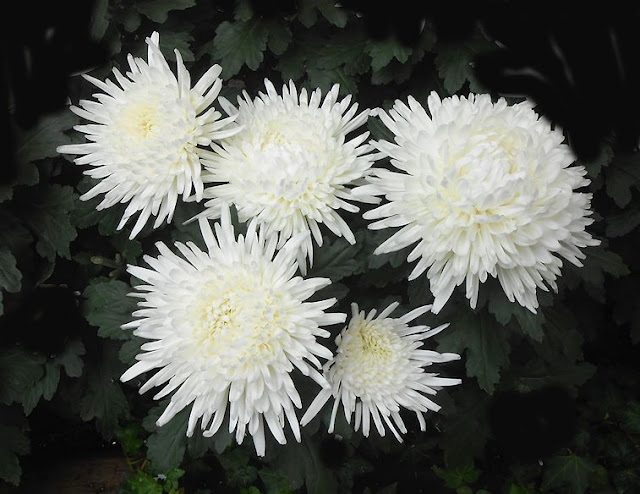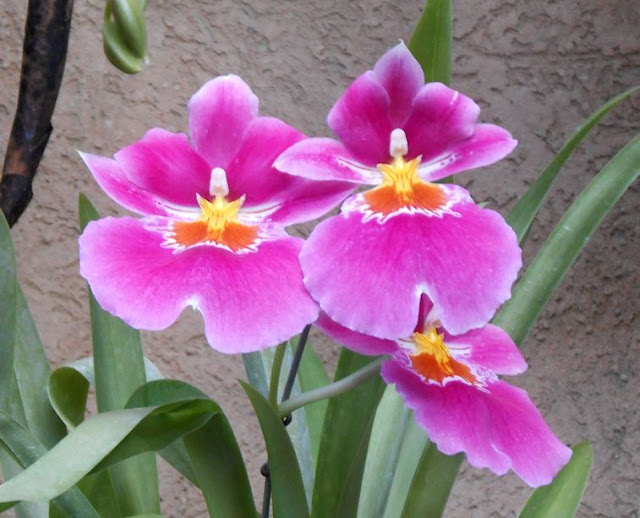This is the largest single chrysanthemum plant ever grown with 1523 flowers.
It took 18 months of training and 2,000 manhours of work. It was trimmed and
pruned and bent and tied to the metal rack which supports the flowers. It bloomed
for more than a month this fall.
This is the East Conservatory entranceway. There is a topiary pyramid of mums,
colorful croton, and blue sage.
The topiary pyramids are made of "Two-Tone Pink Mums" on a metal frame.
Blue Sage
The East Conservatory with "Bill Holden Pink Mums" and "Natalini White Spider Mums"
"Bill Holden Pink Mums" and "Natalini White Spider Mums"
"Lone Star" white quill mums filled the boxes by the door.
"Lone Star" quill mums
Splendid example of a "Lone Star" mum, which looks like a diamond brooch.
"Mt. Shasta" white mums and "Bola de Oro" yellow mums.
The plants are eight feet high. Mums only bloom when there is less than 12 hours
of daylight each day. To get longer stems, start the plants early in the spring and give them
more than 12 hours of light a day as the stems grow. Then when the shorter days of fall
arrive, buds will set and flowers will bloom on the long stems.
Giant "Bola de Oro" yellow chrysanthemums.
The Camellia Wing of the East Conservatory. All the large bushes here are camellias
of many colors. The grates on the floor are part of the heating system, with large
underground tunnels. A group of small children is engaged in a project beneath
a ball of yellow mums.
Hanging ball of yellow mums; they are lowered on a pulley every day and watered.
One of the white camellias, as pure as white can be.
"Babe Harrison " pink camellias. There were a number of bushes in full bloom
by the upper pond in the East Conservatory, just to the right in the picture below.
The length of the East Conservatory showing both the smaller dome of yellow mums
in front and the Big Mum with 1.523 flowers in the back.
This is a bed of medium-sized "Moonbeam" white mums. Different forms and
colors of mums are shown in each of the conservatories.
A large bed of "Lone Star' white mums.
"Flame Symbol Orange" was a beautiful yellow-orange mum, which was used at
the base of several palm trees.
This is a single chrysanthemum plant, which has had 100 prize winning varieties of
chrysanthemums grafted onto it. You can see the single stem at the bottom. It is on a
rotating platform, and you are permitted to slowly rotate the plant so that you can see
each of the 100 prize varieties of mums blooming.
"Pink Delight" is one of the 100 prize varieties.
Three more of the prize winning varieties on the single stem.
Three prize winning varieties on the single stem.
"Honey" quill mum on the giant plant.
"Ashanti Blood" mussaenda. This looks like a large poinsettia 6 feet high, with
many flowers. But it is a mussaenda plant from South Africa. We have these plants
in cream and in pink in South Florida, and they are fairly common. But this is the first
time I have seen this brilliant red color.
As soon as a mum begins to wilt, it is removed overnight and a whole new set of plants,
being prepared in the greenhouses, is brought in. On my second day at the Gardens,
these beautiful "St. Tropez" mums suddenly appeared by the upper pond in the
East Conservatory. They were a rich, glowing red and yellow.
Two "St. Tropez" mums newly planted while I was there.
Mums can be trained to grow in every shape desired. In this case, to go along with the
Chinese Lantern theme, these metal pagoda-like forms were used. Each is made up of a
single chrysanthemum plant whose branches have been trained to grow around the rack.
Floating on the pond are little lily-like plastic shells with an electric votive light inside;
they were very special during the night time visit.
Close-up showing branches of mum plant trained to form pagoda.
Longwood has a collection of 6,000 different orchids in several greenhouses; they are
gradually expanding to 10,000. Orchids are the most diverse flower in the world. One
display conservatory is used just for orchids, and there are hundreds of plants in full bloom
at all times. Each morning, a special attendant checks the Orchid House and if any plant
has begun to loose its flowers, it is replaced with another plant in full bloom. So for
visitors, there are always a couple of hundred different orchids in full bloom. There is
also someone present at all times to answer questions about growing orchids.
A cluster of orchids.
A spray of white orchids. Some grow as single, exhibition blossoms; others grow in pairs
or trios or clusters; and others, usually smaller, cover an entire branch as a spray.
Pale green orchids.
Beautiful white and lavender orchids.
A branch full of small yellow orchids.
This lavender colored orchid was featured in a glassed niche.
A pot of spotted orchids.
Two yellow orchids with long, tubular petals.
Deep magenta orchids.
Purple phaelanopsis orchids.
A cluster of white orchids.
Big luxurious cattleya orchids.
PAle yellow and purple orchids.
Eastern Pennsylvania was still enjoying fall color while I was there, and so I drove
along country highways to enjoy the colors. Yellow, copper, ochre, brown, and deep orange
covered the maple trees.
Close-up of a colorful sugar-maple in front of the Brandywine River Art Museum.
Two strikingly orange sugar maples outside a boarding school on Hwy 52.
Close-up of orange sugar-maples.
And outside the dining room at the Botanic Gardens was a row of golden yellow
gingko trees. I had seen them as green, pale green, and light yellow before,
but I had never seen them in their full yellow glory like this year. They were
glorious.
gingko trees. I had seen them as green, pale green, and light yellow before,
but I had never seen them in their full yellow glory like this year. They were
glorious.
I hope you have enjoyed this visit to Longwood Gardens as much as I enjoyed
visiting in mid-November.
visiting in mid-November.
___
















































